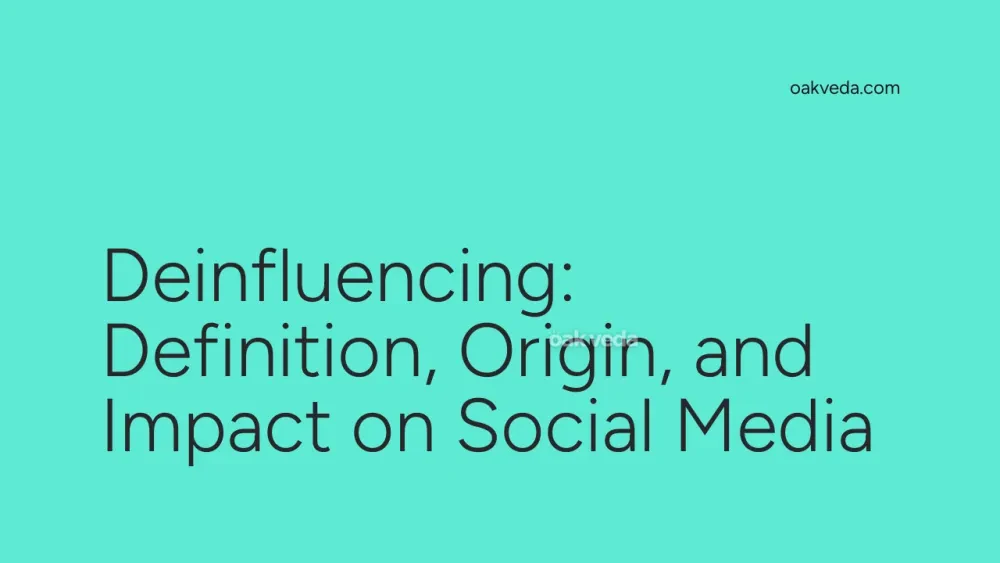
What is Deinfluencing?
Deinfluencing is a growing social media trend where influencers advise their followers against purchasing certain products or services. This phenomenon represents a shift from traditional influencer marketing, where content creators typically promote and endorse items. Instead, deinfluencers provide honest, often critical reviews of popular or overhyped products, steering their audience towards more informed purchasing decisions.
Origin and Development of Deinfluencing
The deinfluencing trend emerged in early 2023 on platforms like TikTok and Instagram. It gained traction as a response to the oversaturation of product promotions and the increasing skepticism among consumers towards influencer recommendations. The movement began primarily in the beauty and lifestyle niches but quickly spread to other sectors, including technology, fashion, and home goods.
How Deinfluencing Works
Deinfluencing operates on the principle of reverse psychology and trust-building. Content creators share their negative experiences with products, explaining why certain items may not be worth the hype or price. They often provide alternative suggestions or encourage followers to make more mindful purchasing decisions. This approach aims to establish credibility and authenticity with their audience.
Types of Deinfluencing Content
- Product Critiques: Detailed reviews highlighting the shortcomings of popular products.
- Dupes and Alternatives: Suggesting more affordable or effective alternatives to trending items.
- Overconsumption Awareness: Content that addresses the environmental and financial impacts of excessive buying.
- Honest Brand Reviews: Unfiltered opinions about brands, including their practices and product quality.
Popular Examples of Deinfluencing
Several deinfluencing campaigns have gained significant attention:
- Beauty influencers critiquing high-end skincare products and suggesting drugstore alternatives.
- Tech reviewers advising against purchasing the latest smartphone models, highlighting minimal improvements over previous versions.
- Fashion content creators exposing fast fashion practices and promoting sustainable clothing options.
Impact of Deinfluencing on Social Media Culture
Deinfluencing has significantly impacted social media culture in several ways:
- Increased Transparency: It has fostered a more honest dialogue between influencers and their followers.
- Consumer Empowerment: Audiences are becoming more discerning and critical in their purchasing decisions.
- Shift in Marketing Strategies: Brands are adapting to this trend by focusing more on authentic partnerships and product improvements.
- Trust-Building: Influencers who engage in deinfluencing often see increased credibility and loyalty from their audience.
Controversies Surrounding Deinfluencing
While deinfluencing has been largely welcomed, it's not without controversy:
- Authenticity Concerns: Some critics argue that deinfluencing is just another marketing tactic to build trust before future promotions.
- Impact on Small Businesses: There are concerns that widespread deinfluencing could disproportionately affect smaller brands with limited marketing budgets.
- Potential for Misinformation: Without proper research, deinfluencers might spread inaccurate information about products or companies.
How Brands and Influencers Use Deinfluencing
Smart brands are adapting to the deinfluencing trend by:
- Embracing transparency in their marketing.
- Collaborating with influencers for honest product feedback.
- Focusing on product quality and value rather than hype.
Influencers are using deinfluencing to:
- Build stronger connections with their audience.
- Diversify their content beyond traditional product promotions.
- Position themselves as trusted advisors rather than mere advertisers.
Future Trends Related to Deinfluencing
As deinfluencing continues to evolve, we can expect:
- More Nuanced Content: Influencers may offer more balanced reviews, highlighting both pros and cons of products.
- Focus on Sustainability: Increased emphasis on eco-friendly and ethical consumption.
- Integration with AI: Use of AI tools to provide more data-driven product comparisons and recommendations.
- Regulatory Scrutiny: Potential regulations to ensure truthful and transparent deinfluencing practices.
FAQs about Deinfluencing
Q: Is deinfluencing just another marketing strategy? A: While some view it as a trust-building tactic, many influencers genuinely aim to provide honest, valuable information to their followers.
Q: How does deinfluencing affect brand partnerships? A: It's changing the dynamics of influencer-brand relationships, with a greater emphasis on authentic, long-term partnerships rather than one-off promotions.
Q: Can deinfluencing help combat overconsumption? A: Yes, by encouraging more thoughtful purchasing decisions, deinfluencing can contribute to reducing unnecessary consumption.
Q: How can consumers distinguish genuine deinfluencing from disguised marketing? A: Look for consistent honesty, disclosure of partnerships, and evidence-based critiques rather than vague or overly negative comments.
In conclusion, deinfluencing represents a significant shift in the social media landscape, challenging traditional influencer marketing models. As consumers become more discerning and demand greater authenticity, this trend is likely to shape the future of digital marketing and consumer behavior. Whether it's a lasting movement or a passing phase, deinfluencing has already left its mark on how we interact with and consume content on social media platforms.
You may be interested in:
- Alt-Text: Definition, Origin, and Impact on Social Media
- Terms of Service (ToS): Definition, Origin, and Impact
- Referral Traffic: Definition, Origin, and Impact
- Fam: Definition, Origin, and Impact on Social Media
- Shook: Definition, Origin, and Impact on Social Media
- Marketing Proposal: Definition, Origin, and Impact

